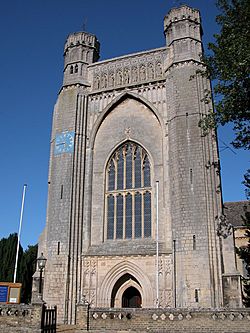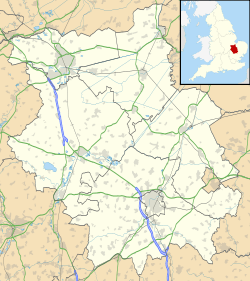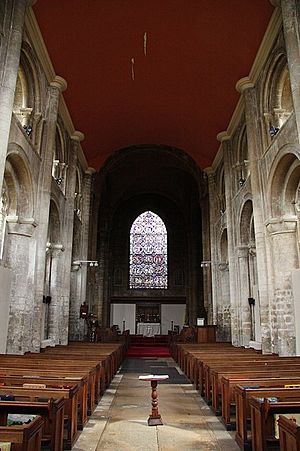Thorney Abbey facts for kids

Thorney Abbey Church
|
|
| Monastery information | |
|---|---|
| Order | Benedictine |
| Established | 972 |
| Disestablished | 1539 |
| Architecture | |
| Heritage designation | Grade I listed building 1331263 |
| Designated date | 22 October 1952 |
| Site | |
| Location | Thorney, Cambridgeshire |
| Coordinates | 52°37′13″N 0°06′26″W / 52.6204°N 0.1072°W |
| Website | thorneyabbey.co.uk |
Thorney Abbey, now known as the Church of St Mary and St Botolph, was an important religious building in medieval England. It was built on an island called Thorney in a marshy area of Cambridgeshire, England, known as The Fens.
Contents
The Abbey's Story
The story of Thorney Abbey began a very long time ago, around the mid-600s. At first, it was a small, quiet place for religious people called a hermitage. Sadly, this early building was destroyed by Vikings in the late 800s.
A new Benedictine monastery was started in the 970s. After the Normans took over England in 1066, a huge rebuilding project began. A new church started being built in 1085 under a leader named Gunther of Le Mans. It was ready to be used by 1089, but it wasn't fully finished until 1108.
King Henry I was a supporter of the Abbey. He even made sure that a piece of land called Sawbridge was returned to the Abbey, so there would be no more arguments about it.
Over time, the main part of the settlement moved away from the edge of the marsh. The older area became a place where rubbish was dumped, perhaps because of rising water. Later, in the 1200s and 1300s, people started using the old site again. They laid down layers of clay to make strong foundations for new wooden buildings. Even bigger buildings were put up in the 1500s. These might have been used as guesthouses, stables, or workshops for the growing abbey.
The End of the Abbey
Many of Thorney Abbey's buildings disappeared after the Dissolution of the Monasteries. This was a time in the 1500s when King Henry VIII closed down many monasteries in England.
The last abbot, Robert Blythe, supported the King. He even signed a letter to the Pope, saying the King should be allowed to get a divorce. Because of his support, he received a good pension of £200 a year.
The Abbey was given to the King's officials on December 1, 1539. Most of its buildings were then taken down, and the stones were used for other constructions. The land was later given to John Russell, 1st Earl of Bedford in 1549 or 1550.
Thorney Abbey Today
Luckily, the main part of the church, called the nave, survived. It was repaired and became the Parish Church of St Mary and St Botolph in 1638. At this time, the side parts of the church were removed, and the archways were walled up. Some beautiful stained glass windows were added. These might have come from a place in London called the Steelyard, which was a trading center.
The current east end of the church was built in the Norman style by an architect named Edward Blore. This part dates from 1840-1841. Today, the church is a Grade I listed building, which means it's a very important historical building.
You can see a model of the monastery at the Thorney Museum. There is also a Grade I listed house in the village of Thorney that is also called Thorney Abbey. This house was built in the late 1500s and 1600s.
Important Burials
Because Thorney was a large and important abbey in Anglo-Saxon England, many important people were buried and honored there. Some of these include:
- Athwulf of Thorney
- Benedict Biscop
- Botwulf of Thorney
- Cissa of Crowland
- Herefrith of Thorney
- Huna of Thorney
- Tancred of Thorney, a religious person who died for their beliefs in the 800s.
- Torthred of Thorney, Tancred's brother.
- Tova
- Wihtred of Thorney
- Albinus of Thorney, an Anglo-Saxon bishop and saint.
Discoveries from Excavations
In 2002, archaeologists from the University of Leicester dug up parts of the area before new buildings were put up. They focused on the northern edge of what used to be the island.
During their dig, they found many interesting things. These included pieces of pottery, animal bones, and roofing materials. They also found a large amount of painted glass from the 1200s and 1300s. This glass had very detailed and beautiful designs, showing how skilled the artists were.
Images for kids







